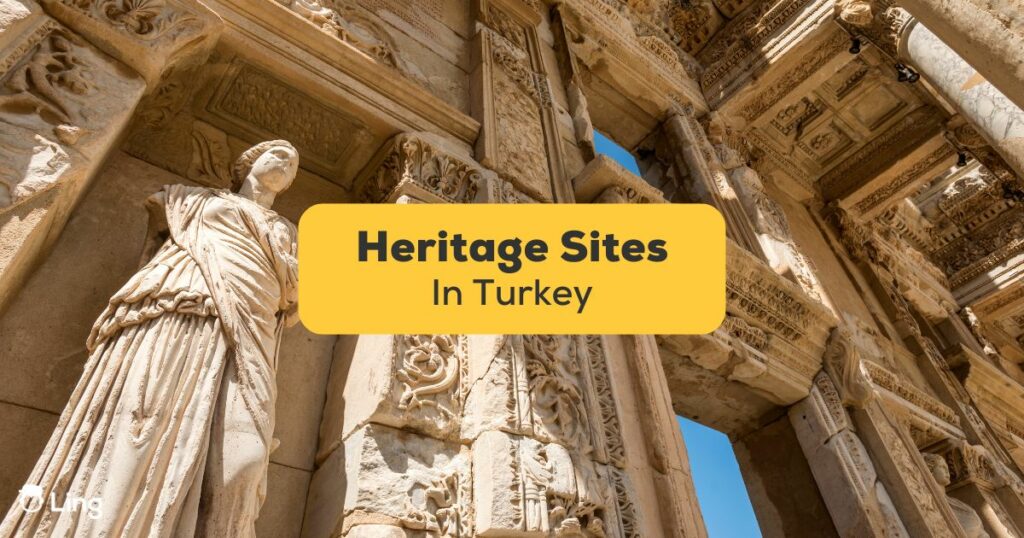Turkey is filled with beautiful heritage sites that you need to see. From the ancient temples of Göbeklitepe, which are a whopping 12,000 years old, to the impressive ruins of Ephesus—these places will take you on a journey back in time!
In this blog post, we’ll explore amazing UNESCO World Heritage Sites in Turkey that you absolutely must visit. Whether you’re into history, love architecture, or just enjoy discovering new places, these sites will fascinate you and give you a real sense of Turkey’s rich past.
Table of Contents
UNESCO World Heritage Sites In Turkey
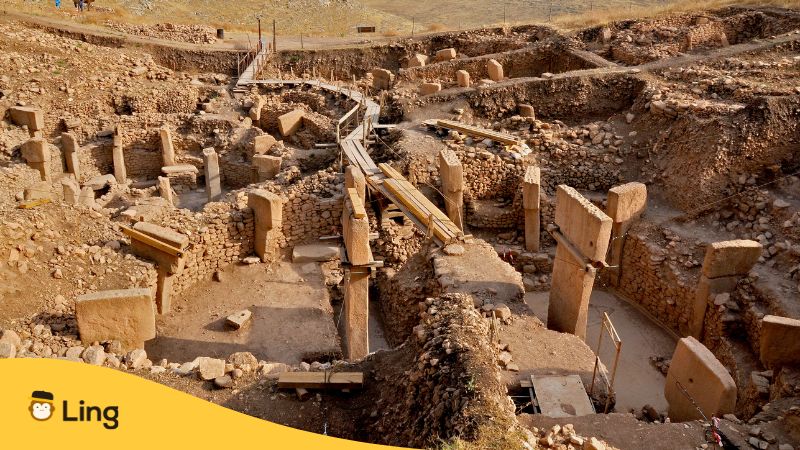
1. Göbeklitepe (Şanlıurfa)
Göbeklitepe, which rewrote all that was written and changed history, is located 15 km away from Şanlıurfa. The open-covered religious buildings, which date back to 12 thousand years ago and are determined to be 20 in total, confirm to us that they are the first temples known in the world to date. Obelisks and temples reaching a height of 6 meters manage to fascinate both experts and visitors who are interested in history and culture.
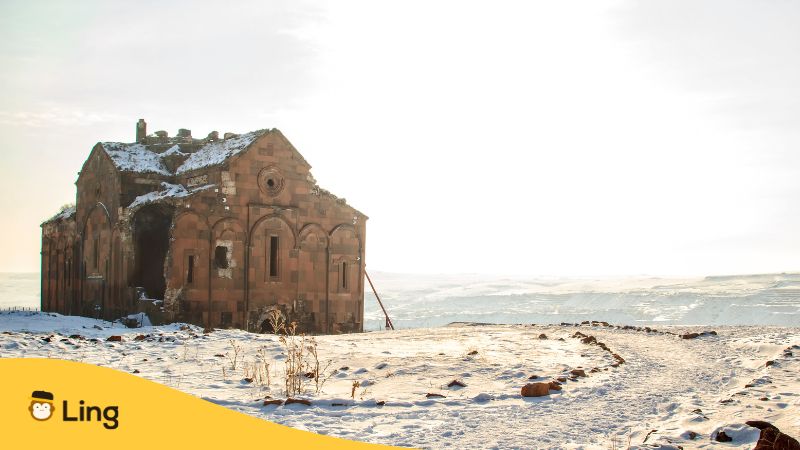
2. Ani Archaeological Site (Kars)
The city of Ani was founded on the banks of the Arpaçay River, 48 km away from Kars, close to the Turkish-Armenian border. Founded on the Silk Road, Ani has hosted many civilizations throughout history. It is possible to see the effect of this diversity in its architecture. Although it bears intense traces of Armenian architecture, you can still see examples of Georgian and Seljuk architecture in this unique archaeological site.
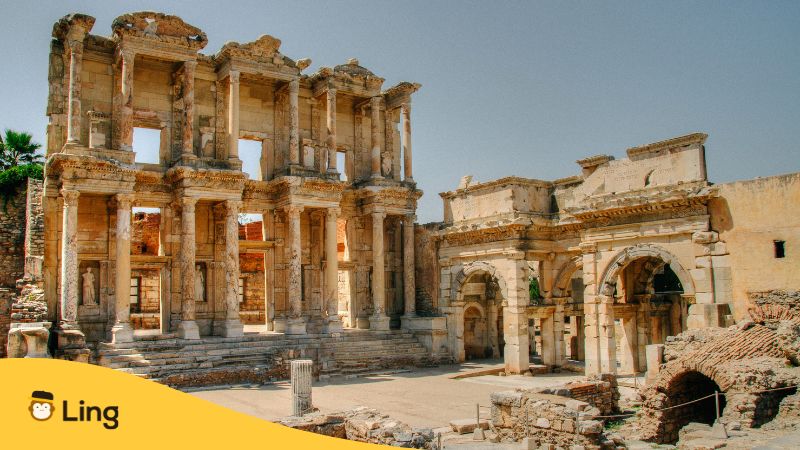
3. Ephesus (Izmir)
It is located in the Selçuk district of Izmir and was founded in B.C. Dating back to 6000 BC and the Neolithic Age, the Ancient Greek City of Ephesus defies the years. Ephesus, the largest Greco-Roman city excavated in the world, was called Asia Minor and the Anatolia province’s capital at that time. The Greek civilization controlled this ancient city and then the Roman civilization; hence, it is equipped with the architectural and cultural traces of these rich civilizations. Ephesus was the star of its time in religious, commercial, cultural, and artistic terms, which reminds you of the power of ancient Rome.
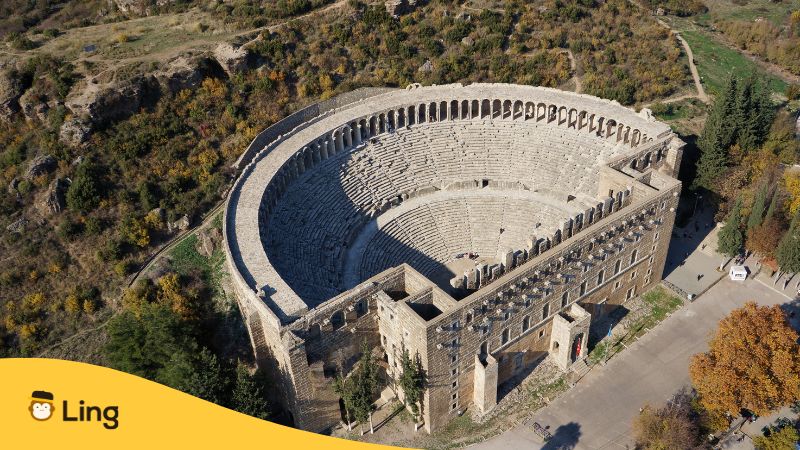
4. Aspendos Ancient City (Antalya)
The ancient city of Aspendos, located in Antalya, is a popular historic destination for visitors to the Turkish Riviera. This town, which is part of the beautiful city of Pamphylia, was created in 1000 BCE. Its acoustic characteristics are exceptional, providing an unparalleled experience for its visitors. It is one of the best-preserved ancient theaters ever, hosting numerous festivals and performances throughout the year.
If you want to add some history to your stay on the Turquoise Coast, the nearby towns of Perge and Side should be on your travel bucket list as well.
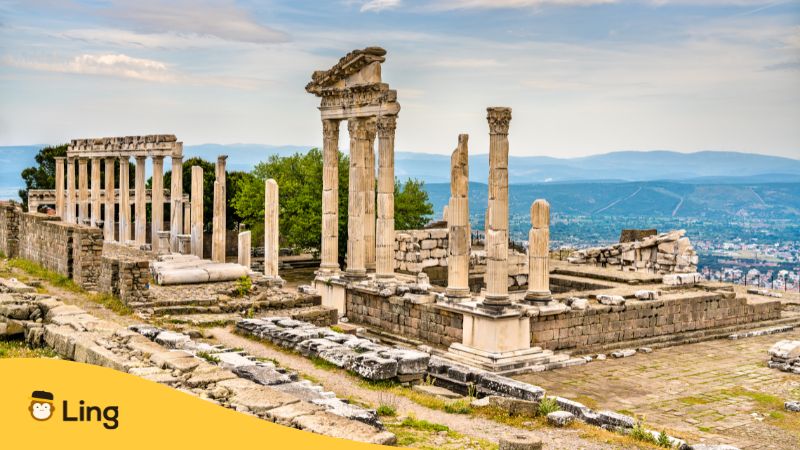
5. Bergama (Izmir)
Bergama is a multi-layered cultural landscape area and a massive ancient settlement site that has gone through the Hellenistic, Roman, Eastern Roman, and Ottoman periods. The area has nine components: Pergamon (multi-layered city), Cybele Sanctuary, İlyas Tepe, Yığma Tepe, İkili, Tavşan Tepe, X Tepe, A Tepe, and Maltepe Tumuli. It’s like going on a history voyage with Ottoman Era constructions layered over Roman and Eastern Roman periods.
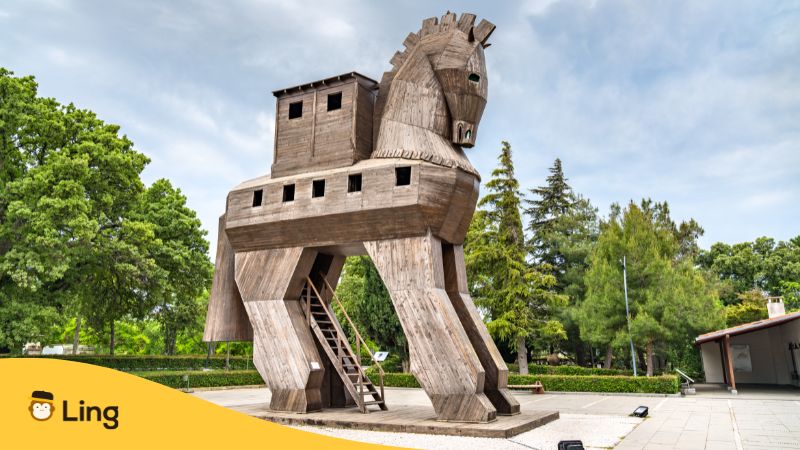
6. Troia Ancient City (Çanakkale)
Troia, with its 4,000-year history, is likely one of the world’s most well-known and important archaeological sites anywhere. Homer immortalized the place and the historic Siege of Troia in the Iliad, and they have since been represented in numerous books and films. The Siege of Troia began when Helen (wife of Agamemnon of Mycenae) eloped with Paris, a prince of Troia. It lasted for years and concluded with a simple trick: Achaean warriors hid in this massive wooden horse and pretended to have fled. The Trojans took the horse inside their walls, opening their gates to the Achaeans. Troia was burned down, and the people were killed.
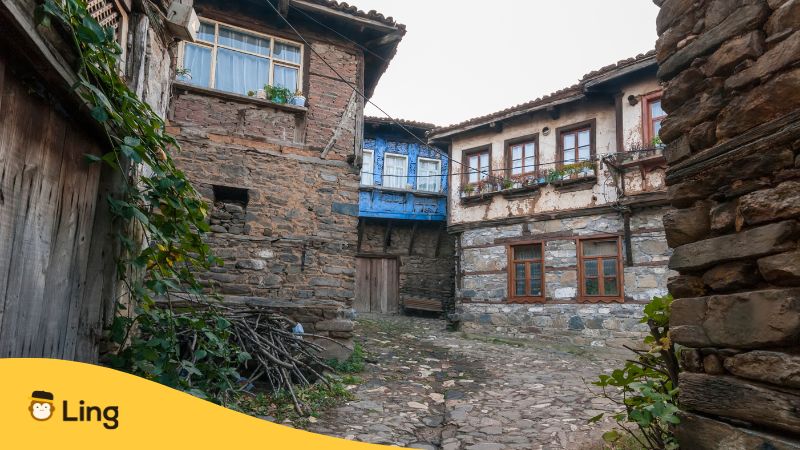
7. Cumalıkızık (Bursa)
Bursa and Cumalıkızık are a cultural heritage that has survived to the present day, shedding light on the way of life of the Ottoman Period. Founded on the southern foothills of Uludağ, Cumalıkızık, one of the most beautiful examples of Ottoman rural architecture, has a history of 700 years. Cumalıkızık, which hosts original examples of traditional Ottoman architecture and civil architecture, was one of the leading powers of Bursa, the first capital of the Ottoman Empire. You’ll understand this better when you visit the buildings in the Khans Area.
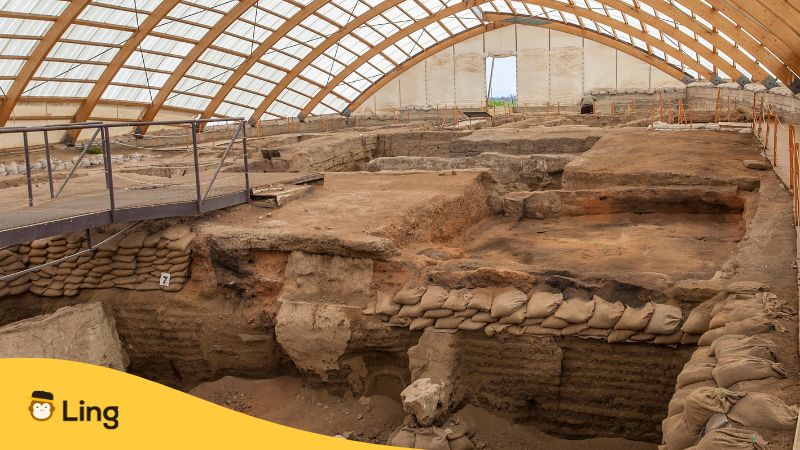
8. Çatalhöyük Neolithic Site (Konya)
Çatalhöyük Neolithic City, located in the Çumra district of Konya, is one of the ancient living places that helps us understand human history. History BC During Çatalhöyük, dating back to 7400 BC, 10 thousand people lived. It is an enormous ancient city where the beginning of social life and the transition to agricultural society can be examined. The city, which had a large population compared to that period and yet had no social or economic differentiation, shows traces of an orderly life.
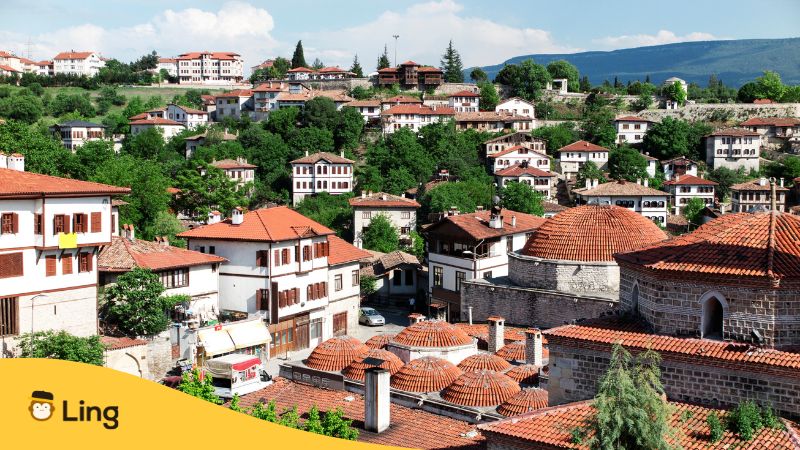
9. Safranbolu (Karabük)
Safranbolu, which has always been an important and lively city on the road connecting the Black Sea coast to Western, Northern, and Central Anatolia, became one of the indispensable stops of trade between Asia and Europe in the 18th century. The center of the city, which was under Roman, Byzantine, Seljuk, and Ottoman domination, reflects the traditional urban texture of the Western Black Sea region. It is a living value with its traditional wooden houses and monumental buildings.

10. Xanthos-Letoon (Turkish Riviera)
Xanthos-Letoon, located in Turkey’s Antalya and Muğla provinces, is a UNESCO World Heritage site known for its impressive archeological complex. According to sources, Xanthos served as the consecutive capital and a cultural and commercial center for the Lycian Civilization and subsequent civilizations. The location currently provides numerous clues regarding Lycian customs because the epigraphic inscriptions, cut in rock or on massive stone pillars, include the most important writings in the Lycian language. Its instances of Lycian tomb building, as well as the Xanthian Obelisk, are must-sees.
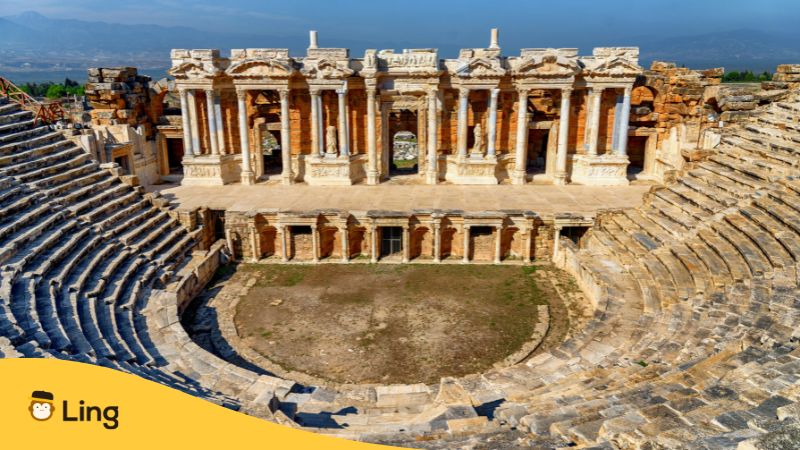
11. Hierapolis (Denizli)
Hierapolis ancient city, which has been on the UNESCO World Heritage List since 1988, is an ancient city that was once the center of an eparchy and now houses an archeological museum. It is located on some hot springs that have been utilized as a spa since the second century BCE. The earliest known instances of crank and rod mechanisms are on display in the area, and tourists can explore the ruins of ancient baths, temples, and other buildings.
The Necropolis, which contains 1,200 tombs adorned with local limestone and marble, Ploutonion (Pluto’s Gate), and the St. Philip Martyrium, named after the Christian apostle, are among the most prominent destinations to visit.
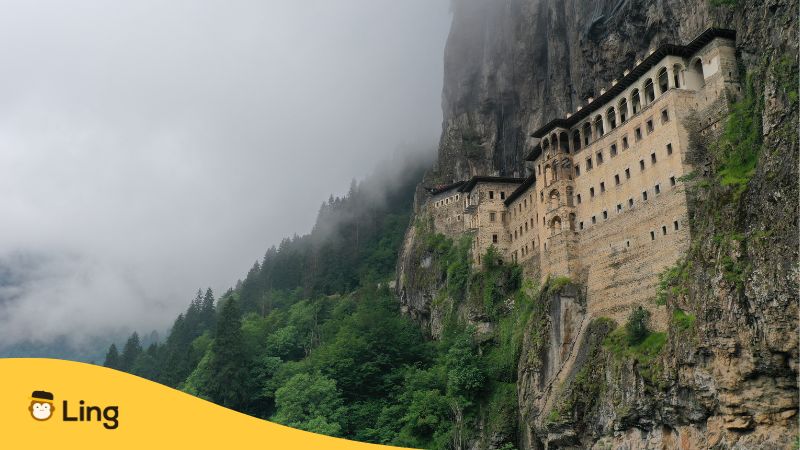
12. Sümela Monastery (Trabzon)
Sümela Monastery overlooks the valley of Altındere, offering a picture-perfect view unique to Turkey. It was initially built as an Orthodox monastery dedicated to the Virgin Mary. The Turkish Ministry of Culture and Tourism dates its foundation to around 386 CE, during the time of Emperor Theodosius (375-395). The monastery has fallen into disrepair multiple times over its history, with the most recent renovation taking place in 2015.
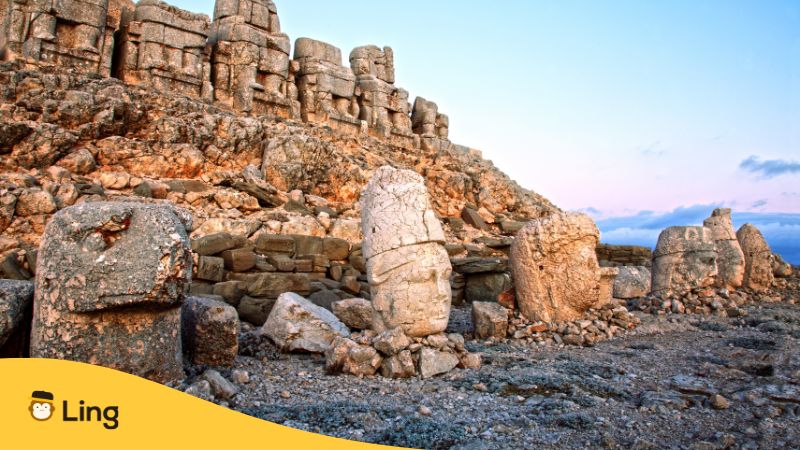
13. Mount Nemrut (Adıyaman)
The painting depicts Antiochus I’s (69-34 BCE) mausoleum, which he built as a tribute to himself. These massive limestone sculptures in Mount Nemrut depict not only deities but also Antiochus’ paternal Persian and maternal Macedonian forebears. They thus provide a testament to the kingdom’s culture’s multiple origins, which have been enriched by Persian and Macedonian influences.
How Do You Say “Heritage Site” In Turkish?
“Heritage site” in Turkish is translated as miras alanı. For example, if you want to say “UNESCO World Heritage Site,” you can say UNESCO Dünya Miras Alanı in Turkish.
Related Turkish Vocabulary About Heritage Site
Using this table, you can learn Turkish vocabulary related to heritage sites, ancient history and so on.
Frequently Asked Questions About Heritage Sites In Turkey
1. How Many Heritage Sites Are There In Turkey?
As of 2024, Turkey has 21 UNESCO World Heritage Sites, which include a mix of cultural and natural sites. These sites reflect Turkey’s rich historical, architectural, and natural heritage.
2. What World Heritage Site Is In Istanbul, Turkey?
The most notable UNESCO World Heritage Site in Istanbul is the Historic Areas of Istanbul. These include major landmarks such as the Hagia Sophia, Topkapi Palace, and the Sultan Ahmed Mosque (Blue Mosque). Due to their historical and cultural significance, these areas were inscribed on the World Heritage list in 1985.
3. Is Hagia Sophia A UNESCO World Heritage Site?
The Hagia Sophia is indeed a UNESCO World Heritage Site. It is part of the Historic Areas of Istanbul and was recognized for its architectural grandeur and historical importance as both a cathedral and a mosque.
4. What Heritage Is Turkish?
The heritage that is considered distinctly Turkish includes a variety of cultural traditions, historical sites, and culinary practices that have evolved over centuries. Examples include the ancient city of Troy, the rock sites and ancient ruins of Cappadocia, the Great Mosque and Hospital of Divriği, and the traditional art of Turkish carpet weaving.
To Sum It Up
Turkey’s UNESCO Sites offer a fascinating journey through time, showcasing the country’s rich history, culture, and natural beauty. From the ancient wonders of Göbeklitepe and Troy to the architectural marvels of Ephesus and Aphrodisias, each site provides a unique glimpse into the civilizations that have shaped heritage sites in Turkey.
Whether exploring the religious significance of Sümela Monastery or the monumental splendor of Mount Nemrut, visitors are sure to be captivated by the diverse stories and remarkable preservation of these sites. Turkey’s dedication to conserving its heritage ensures that these treasures continue to educate and inspire future generations, highlighting the importance of cultural preservation on a global scale.
